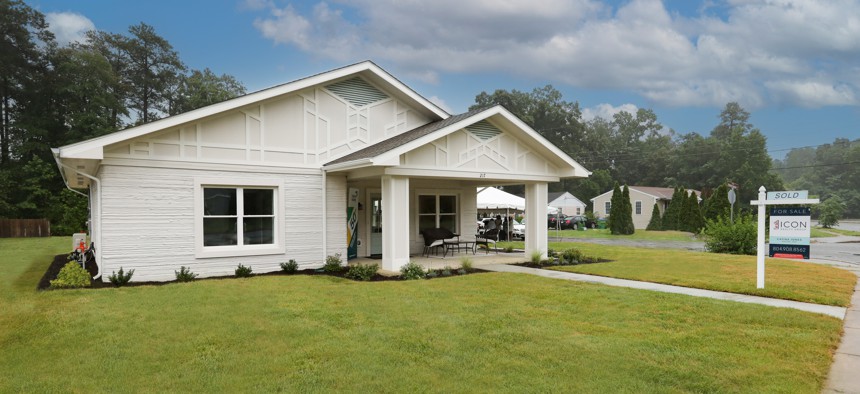3D-Printed Homes Save Time, Money, State Pilot Shows

A 3D-printed house sits in Richmond, Virginia. Photo courtesy of Chris Thompson, director of strategic housing for Virginia Housing.

Connecting state and local government leaders
A potential solution to Virginia’s housing shortage comes from the nozzle of a 3D printer.
Among the many wood-frame houses that sit on Carnation Street in Richmond, Virginia, the city’s first 3D-printed home has housed a family since July. A second home completed in early 2022 can be found in James City County.
Virginia, like many states, has an housing inventory shortage both in rental and homeownership opportunities, said Chris Thompson, director of strategic housing for the commonwealth’s housing finance agency, at the Future Cities Summit hosted by Route Fifty. 3D printing offers affordable housing to residents much faster than traditional construction methods.
For example, the James City County home was built in 20 hours spaced out over time to allow the walls time to cure and engineers and masons to inspect the building’s integrity. This method, while still an emerging technology, is expected to facilitate significant savings in terms of time and money, Thompson said in an interview.
Using a system from COBOD, a company that provides modular printing configurations and construction services, users enter a wall system diagram into geocoding software that creates a simulation of what the project would look like, similar to computer-assisted drawing. Construction entails feeding the 3D printer, called BOD 2, concrete that the nozzle head dispenses as it replicates the wall system footprint. The printer moves along a gantry on the perimeter of the house, pausing when it reaches a break in the diagram – such as a window – before it continues at the next print point.
“Essentially it goes around and around and around, building layer upon layer almost like building a cake until you reach your desired height,” Thompson said in the webinar.
Staff can monitor metrics such as workflow, speed of the printer and building performance from a nearby operations center. The system includes a joystick for manual construction as well, but Thompson said this is not recommended as wall system specs are very precise.
Once the walls are finished, traditional construction such as mechanical, electrical and plumbing installation follows. No technical or safety issues have been reported since the technology’s deployment, Thompson said, as state and local building officials conduct regular inspections. There was a minor delay at the Richmond site, however, when overnight someone nabbed the printer head nozzle, temporarily halting construction. The system was back up and running in a few hours thanks to a technician who 3D printed a replacement nozzle.
The 3D-printed houses incorporate a Raspberry Pi-based system that collects indoor environmental data for smart building applications such as air quality, temperature, sound and gas monitoring. The system provides data on energy consumption optimization and analysis on occupant comfort and space utilization, Thompson said. The data transmission occurs through the homeowner’s Wi-Fi, eliminating running costs.
The HFA recently awarded a $500,000 grant to the Virginia Center for Housing Research at Virginia Tech to secure a 3D modular construction printer as part of a larger mission to spur new construction processes and building techniques. Thompson said the agency’s excess revenues also helped finance the project.
“We are hoping our initial investment was enough to catalyze the industry, show that it works, give some proof of concept and then let the private market come in,” Thompson said.
The agency also works with Alquist, a company that specializes in 3D printing, local nonprofits and state partners such as the Department of Housing and Community Development. Virginia has upcoming plans to 3D print two more homes in Pulaski.
Other states such as Texas, Iowa, Florida and Tennessee have also ventured into the 3D-printed housing space.
“It’s not the answer to solving the housing crisis, but it can certainly be a complement,” Thompson said.

NEXT STORY: States Must Plug Into Federal Antifraud System for Food Aid Under New Rule





